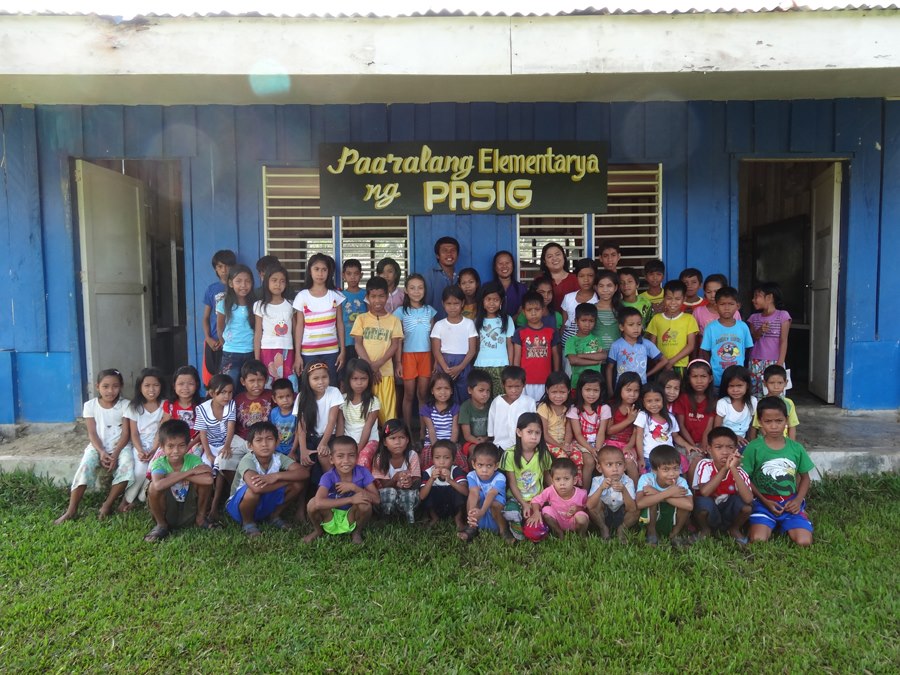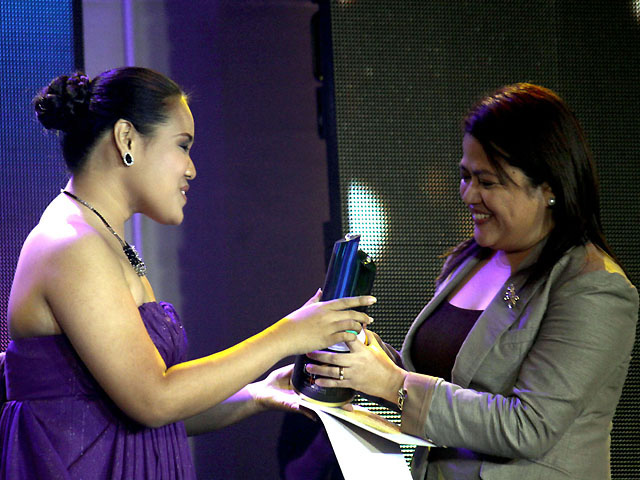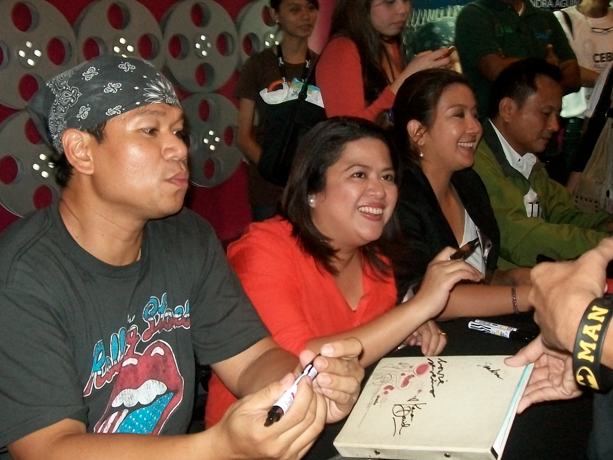In 2008, Sandra Aguinaldo’s documentary ‘No Kubeta’ featured a community that had no indoor plumbing. When night fell, she went into the jungle to do her business the way locals did, emerging with a small laugh: ‘Ang dilim!’ Watch any of her documentaries, and you’ll catch her smiling while interviewing a case study, giggling with children and injecting a bit of self-deprecating humor to diffuse awkward situations. Her easygoing, affable nature has made Sandra popular with viewers, but a look back on her career makes it clear this reporter is anything but a lightweight. War stories As a field reporter, Sandra was tasked to cover Abu Sayyaf, MILF and MNLF activities in Basilan, Jolo, and other conflict-ridden areas. “Palagi kong naalala yung mga dangerous assignments,” she says. “Talagang mate-test yung abilities mo not just in delivering the news but in making sure that you and your team are safe.” Sandra, who grew up in Angono and graduated from the University of Santo Tomas, has had her share of close shaves, too. While in Sulu, she reported that a MILF breakaway group had set a barangay on fire. She rode a jeep back to the boarding house the team was staying at, unaware of any danger until she got a call from a source. “Nasaan ka? Nasaan ka?” she was asked. “Sabi ko, ‘Nandito ako, nakabalik na kami sa Jolo,’” recalls Sandra. “Tapos parang in panic siya—“Kukunin ka nila, kukunin ka nila…Inaabangan nila yung jeep mo. Hindi ka nila nakita.” She kept calm and called the nearest military camp—and was surprised by what she heard. “Sabi [ng officer], ‘Oo, may na-intercept kaming intelligence report na may kukuha nga sa iyo, may kikidnap. Nagpadala na kami ng tao to secure you,’” says Sandra. Working in media often requires on to look their best, but Sandra says covering war stories is a different kind of game. “May kwento dati na baka magustuhan ka [ng Abu Sayyaf], hindi ka na makalabas,” says Sandra. For her own protection, she had to keep a low profile—especially since she would be the only woman in the Abu Sayyaf camp. “Pag nasa bundok kasi kami, ako na pinakamaganda. Wala nang iba eh!” she adds with a laugh. “Ang rule ko, no eye contact, walang suklay, no lipstick, mahaba yung sleeves, oily ang face. Dapat ganun,” says Sandra. “Worst foot forward!” Fresh perspectives Since joining the "I-Witness" team in 2006, Sandra has told the stories of Filipinos from all walks of life. In her documentary entitled ‘Lahat Legal Wife,’ she spent time with a Muslim man and his many wives. Another documentary she did in 2007 called ‘Pag-Ibig sa Magkabilang Daigdig’ featured couples who met online and were going to see each other in person for the first time. She has interviewed Imelda Marcos, eaten out of garbage cans, and gone backpacking across Southeast Asia. For the program’s thirteenth anniversary series, Sandra’s ‘Lihim ng Kanluran’ featured the people and customs of the Molbog tribe of Balabac Island, Palawan. The first time the tribe had ever been filmed by any camera was for this documentary.

A photo by Sandra Aguinaldo, of the Molbog children she mmet in Brgy. Pasig, Balabac Island.
“Madalas, parang nakakalimutan na nilang may camera. Para ka na lang friend nila na kinakausap nila,” says Sandra. “Nakakatuwa yung mga Pinoy na very open, always willing to share their stories.” However, documentary filmmaking is not without controversy. At a recent "I-Witness" docufest held in Baguio a few weeks ago, the hosts were asked a difficult question: in continuing to feature stories of poverty, are documentaries a form of exploitation? Sandra admits this is a common issue, but cites the answer of co-host Howie Severino: “Wala namang extra effort ang ‘I-Witness’ na i-present ang mga mahirap,” she explains. “But the thing is: majority naman talaga ng Pilipinas, mahirap.” Sandra believes the challenge is to find a fresh take on such issues, and that the best stories are ones that inspire others. “When I do stories about poor people, I try to present it in a way na mai-inspire ang mga tao rather than making them feel depressed. Like yung sa ‘Iskul ko No. 1’—mahihirap sila, unsure yung education, yet hinilight na ang tatalino nila,” she says. She’s talking about
her 2007 docu about Sindangan Elementary School in Southern Leyte. In spite of the area’s poverty, the small school placed first in the 2006 National Elementary Achievement Test for graduating students—a feat accomplished by teachers who make visual aids with money out of their own pockets, and students who help each other learn. “Ang sisipag nila,” Sandra recalls. “I feel that the best stories I’ve done are the positive, inspiring stories,” she says. “I’d like to do more stories na ganun—'yung kapupulutan ng aral.”
Beyond reporting The best thing about her job, Sandra says, is the chance to introduce viewers to new perspectives on familiar issues. “It makes you feel good na nagbago 'yung pananaw ng viewers about certain things … You get comments na, ‘biruin mo, nasa paligid ko lang, hindi ko napansin.’” Even better, she says, people are stepping away from their screens to take action of their own. “Napansin kong dumadami yung taong hindi lang naaawa, but they actually offer their help, kahit simple lang,” says Sandra. “Sa ‘Iskul ko No. 1,’ may isang bata doon na ang isang candy, kailangan niyang hatiin sa apat. So nung napanood, may nagpadala ng candy. Marami, pake-paketeng candy!” The stories keep coming. “Mayroon akong na-cover—isa lang tsinelas niya pero ginagamit pa rin niya. May mga nagpadala ng tsinelas na galing pang States. Mga American students, nagpadala ng tsinelas.” Another favorite of Sandra’s is ‘Kubling Yaman ng Cama Juan,’ which featured brilliant students from Nueva Ecija who didn’t have enough money to pursue their dreams of a college education. “May mga galing sa abroad—marami-rami yun—tapos mayroong mga tao na hindi naman mayaman pero gusto lang mag-share. Amazing talaga ‘yun.”
Where are the kids of Cama Juan now? “Yung mga bata, nag-aaral na sila ngayon. Scholars na sila ng iba’t ibang tao na viewers ng 'I-Witness,'” Sandra says with a smile.
A juggling act 
Sandra Aguinaldo receives the USTV Students' Choice for Documentary Award on behalf of I-Witness at the University of Sto. Tomas.
The life of a journalist is not an easy path. Sandra, for example, spends her weekdays reporting news while her weekends are booked for ‘I-Witness.’ She gets two weekends off a month, which she likes to spend at home. “Boring, ‘no?” she jokes. “I just spend quality time din with my husband kasi minsan, parang sa gabi na lang kami nagkikita … Sometimes, I experiment in the kitchen. Minsan naman, masarap daw. Minsan lang!” Perhaps the job of a journalist isn’t so different from that of a juggler, balancing many things—fresh news and bigger issues, professional and personal life, reporting the problem and doing something about it. It’s a tricky, exhausting balance, but Sandra believes it’s worth it. “Minsan, may feeling ka sa ‘I-Witness’ na pagod na pagod ka na physically. Kasi diba, malayo yung pinupuntahan mo, naglalakad ka ng malayo,” she says. “Pero pag [naging daan ang trabaho mo upang mapabuti ang buhay ng iba]—ay, burado na. Hindi ka na pagod.”
-- Fans from the I-Witness Facebook page also had a few questions for Sandra: Methale Cuaycong Alegarbes: Nainis ba kayo kay FPJ? Sandra: I guess nung moment na ‘yun, may misunderstanding kami. Kasi I was doing a standupper, apparently na-distract siya kasi he was making a speech ...Pero the following day, we shook hands and okay na ako doon. Wala na akong problema. Baka akala ng iba na naiinis talaga ako, pero hindi. I’ll always remember him as someone na masarap kakwentuhan. Tapos mabait din siya, in the sense na yung pag kakwentuhan mo siya, kinukuwento niya ang mga fans niya. In-explain niya sa akin off-cam kung bakit niya kinakamayan lahat. Sabi niya, it's because he used to be a fan. A basketball fan. Nahawakan niya lang daw kamay ng idol niya, hindi na makatulog. So it mattered to him na ipahawak niya ang kamay niya o mag-smile sa mga fans niya. I’ll always remember that conversation.
 Rlin Shane: In presenting news and in doing interviews with politicians, how do you do it without any bias? Sandra:
Rlin Shane: In presenting news and in doing interviews with politicians, how do you do it without any bias? Sandra: Pag pumunta ka sa interview, kailangang open 'yung mind mo. Kung minsan, kasi tao lang naman tayo, somehow may assumptions ka about the person. Pero pag humarap ako sa kanila sa interview, tinatanggal ko 'yung biases ko. Mahirap kasi siyempre, tao ka. Kaya ang challenge sa isang journalist—sa isang matinong journalist—is kapag nagsimula ka nang magsulat, kailangang mawala yung biases mo. But for people in power, like politicians, be careful din na baka binobola ka rin nila. So ma-train ka na rin how to detect when someone’s just pulling your leg. Job mo rin na i-confront sila with questions that will challenge 'yung pambobola nila sa iyo.
Anonymous Fan: Do you have any advice for aspiring journalists? Sandra: Be a good listener. Sa I-Witness, marami kaming napupulot na storya dahil narining lang—natisod lang. One time, kumain kami sa karinderya tapos nakalagay sa menu, ‘tapang kabayo.’ Sabi ko, ‘Ano yan?’ Sabi sa akin, ‘Tapang kabayo.’ Ayun, naging magandang documentary siya tungkol sa kung paano kinakatay ang kabayo. Tapos marami akong natutunan doon. Ang kabayo pala, pag napilayan lang, kakatayin na kasi it’s more expensive to keep treating the horse. So nagiging tapa siya. Para sa akin, memorable yung kwentong iyon dahil sa moment na nakuha lang sa karinderya. Para naman sa mga gustong maging reporter, laging makinig talaga sa balita. Be aware of what’s happening around you. Makinig ng AM radio, kahit na para sa ilang kabataan, corny ‘yun. [Laughs] Magbasa ng diyaryo, kahit tabloid ... At syempre ngayon, mahalaga ang social media. —
PF, GMA News Click here to follow Sandra Aguinaldo (@sandraguinaldo) on Twitter. To stay updated on the latest videos and web-exclusives from "I-Witness," like the program on Facebook (facebook.com/IWitnessGMA), follow them on Twitter (@IWitnessGMA) or visit their official webpage. 

 Rlin Shane: In presenting news and in doing interviews with politicians, how do you do it without any bias? Sandra: Pag pumunta ka sa interview, kailangang open 'yung mind mo. Kung minsan, kasi tao lang naman tayo, somehow may assumptions ka about the person. Pero pag humarap ako sa kanila sa interview, tinatanggal ko 'yung biases ko. Mahirap kasi siyempre, tao ka. Kaya ang challenge sa isang journalist—sa isang matinong journalist—is kapag nagsimula ka nang magsulat, kailangang mawala yung biases mo. But for people in power, like politicians, be careful din na baka binobola ka rin nila. So ma-train ka na rin how to detect when someone’s just pulling your leg. Job mo rin na i-confront sila with questions that will challenge 'yung pambobola nila sa iyo. Anonymous Fan: Do you have any advice for aspiring journalists? Sandra: Be a good listener. Sa I-Witness, marami kaming napupulot na storya dahil narining lang—natisod lang. One time, kumain kami sa karinderya tapos nakalagay sa menu, ‘tapang kabayo.’ Sabi ko, ‘Ano yan?’ Sabi sa akin, ‘Tapang kabayo.’ Ayun, naging magandang documentary siya tungkol sa kung paano kinakatay ang kabayo. Tapos marami akong natutunan doon. Ang kabayo pala, pag napilayan lang, kakatayin na kasi it’s more expensive to keep treating the horse. So nagiging tapa siya. Para sa akin, memorable yung kwentong iyon dahil sa moment na nakuha lang sa karinderya. Para naman sa mga gustong maging reporter, laging makinig talaga sa balita. Be aware of what’s happening around you. Makinig ng AM radio, kahit na para sa ilang kabataan, corny ‘yun. [Laughs] Magbasa ng diyaryo, kahit tabloid ... At syempre ngayon, mahalaga ang social media. —PF, GMA News Click here to follow Sandra Aguinaldo (@sandraguinaldo) on Twitter. To stay updated on the latest videos and web-exclusives from "I-Witness," like the program on Facebook (facebook.com/IWitnessGMA), follow them on Twitter (@IWitnessGMA) or visit their official webpage.
Rlin Shane: In presenting news and in doing interviews with politicians, how do you do it without any bias? Sandra: Pag pumunta ka sa interview, kailangang open 'yung mind mo. Kung minsan, kasi tao lang naman tayo, somehow may assumptions ka about the person. Pero pag humarap ako sa kanila sa interview, tinatanggal ko 'yung biases ko. Mahirap kasi siyempre, tao ka. Kaya ang challenge sa isang journalist—sa isang matinong journalist—is kapag nagsimula ka nang magsulat, kailangang mawala yung biases mo. But for people in power, like politicians, be careful din na baka binobola ka rin nila. So ma-train ka na rin how to detect when someone’s just pulling your leg. Job mo rin na i-confront sila with questions that will challenge 'yung pambobola nila sa iyo. Anonymous Fan: Do you have any advice for aspiring journalists? Sandra: Be a good listener. Sa I-Witness, marami kaming napupulot na storya dahil narining lang—natisod lang. One time, kumain kami sa karinderya tapos nakalagay sa menu, ‘tapang kabayo.’ Sabi ko, ‘Ano yan?’ Sabi sa akin, ‘Tapang kabayo.’ Ayun, naging magandang documentary siya tungkol sa kung paano kinakatay ang kabayo. Tapos marami akong natutunan doon. Ang kabayo pala, pag napilayan lang, kakatayin na kasi it’s more expensive to keep treating the horse. So nagiging tapa siya. Para sa akin, memorable yung kwentong iyon dahil sa moment na nakuha lang sa karinderya. Para naman sa mga gustong maging reporter, laging makinig talaga sa balita. Be aware of what’s happening around you. Makinig ng AM radio, kahit na para sa ilang kabataan, corny ‘yun. [Laughs] Magbasa ng diyaryo, kahit tabloid ... At syempre ngayon, mahalaga ang social media. —PF, GMA News Click here to follow Sandra Aguinaldo (@sandraguinaldo) on Twitter. To stay updated on the latest videos and web-exclusives from "I-Witness," like the program on Facebook (facebook.com/IWitnessGMA), follow them on Twitter (@IWitnessGMA) or visit their official webpage. 



